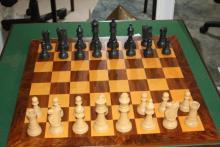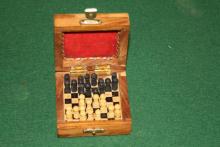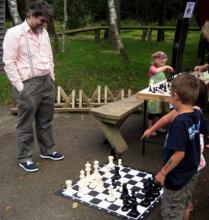| eighth rank seventh rank            Explosions
on Explosions
on          f7,g7 and h7; and f7,g7 and h7; and          on e6,f6,g6 andh6 on e6,f6,g6 andh6          Knights on
e5, f5 or g5 Knights on
e5, f5 or g5                    f-file f-file          g-file g-file          h-file h-file Italian diagonal Long diagonal 'Classic' diagonal |
Contents
Here's a selection of basic attacking ideas for attacking the King castled king's-side; the Queen's-side stuff at the end needs attention. These are the building blocks from which winning attacks are made; examples from actual play are given below. Unless you are playing a particularly unalert opponent, one idea alone will not be forceful enough to win: rather, each decisive idea is usually accompanied by a "supporting cast" of other features of the position.- Rook on eighth rank
- Rook on seventh rank
- Italian diagonal
- Long diagonal
- Classic diagonal
- Open f-file
- Open g-file
- Open h-file
- Knight on e5
- Knight on f5
- Knight on g5
- Explosion on e6
- Explosion on f6
- Explosion on g6
- Explosion on h6
- Explosion on f7
- Explosion on g7
- Explosion on h7
- Creating weaknesses
- Castling Queen's-side
- Boden's mate
Rook on eighth rank
Example: Nielsen - Bohm,Hans [C52] cr, 1979
1.e4 e5 2.Nf3 Nc6 3.Bc4 Bc5 4.b4 Bxb4 5.c3 Ba5 6.d4 d6 7.Qb3 Qd7 8.dxe5 dxe5 9.0-0 9...Bb6 10.Rd1 Qe7 11.a4 a6 12.Ba3 Qf6 13.a5 Ba7 14.Bd5 Nge7 15.Ra2 0-0 16.Bxc6 bxc6 17.Rad2 Rb8
|
Supporting cast: Bishop on a3-f8
18.Rd8 Bg4 19.Qxb8 1-0
Perhaps its most common setting is in the late middle-game or ending:
Example: Regis-Springall, Paignton 1996
|
Supporting cast: Queen with access to e8
26...b6?? 27 Qe8+
Rook on seventh rank
Example: Bastian,Herbert - Eng,Holger [C54] Bad Neuenahr ch-DE (10), 1984
1.e4 e5 2.Nf3 Nc6 3.Bc4 Bc5 4.c3 Nf6 5.d4 exd4 6.cxd4 Bb4+ 7.Bd2 Bxd2+ 8.Nbxd2 d5 9.exd5 Nxd5 10.Qb3 Nce7 11.0-0 0-0 12.Rfe1 Nb6 13.Bd3 Bf5 14.Rxe7 Bxd3 15.Rae1 Bg6 16.Nh4 Nc8 17.Nxg6 hxg6 18.R7e5 Qxd4 19.Nf3 Qd7 20.Ng5 Nd6 21. Qb4
|
Supporting cast: Knight on g5
21....f6 22.Re7 Qb5 23.Rxg7+ Kxg7 24.Re7+ Rf7 [24...Kg8 25. Qh4+-] 25.Rxf7+ Nxf7 26.Ne6+ 1-0
Italian diagonal
This is surely the most basic attacking theme and is present throughout the examples below. I give two more direct exmaples:Example: Schiffers - Harmonist [C55] Franfurt, 1887
1.e4 e5 2.Nf3 Nc6 3.Bc4 Bc5 4.c3 Nf6 5.d4 exd4 6.cxd4 Bb4+ 7.Bd2 Bxd2+ 8.Nbxd2 d5 9.exd5 Nxd5 10.Qb3 Nce7 11.0-0 0-0 12.Rfe1 c6 13.a4 Qc7 14.Rac1 Nf4 [14...Qf4] 15.Ng5 Neg6
|
Supporting cast: Knight on g5, Rook on eighth rank(!)
16.Re8 Rxe8 17.Bxf7+ Kh8 18.Bxe8 Ne2+ 19.Kh1 Nxc1 20.Nf7+ Kg8 21.Nh6+ Kf8 22.Qg8+ Ke7 23.Bxg6 hxg6 [23...gxh6 24.Qf7+ Kd6 25.Ne4#] 24.Qxg7+ Kd8 25.Qf8+ Kd7 26.Ne4 Qd8 27.Qd6+ Ke8 28.Nf6+ 1-0
Example: euwe - thomas [D69] (EUWE), 1934
1.d4 d5 2.c4 e6 3.Nc3 Nf6 4.Bg5 Be7 5.e3 0-0 6.Nf3 Nbd7 7.Rc1 c6 8.Bd3 dxc4 9.Bxc4 Nd5 10.Bxe7 Qxe7 11.0-0 Nxc3 12.Rxc3 Black now plays the final part of Capablanca's freeing manoeuvre. 12...e5 13.dxe5 Nxe5 14.Nxe5 Qxe5 15.f4 Qe7 White has a temporary advantage in development, which is particularly clear in the positions of the Bishops. If White does not sieze the moment, the advantage will vanish, and Black's last move gives White the chance he needs.
|
Supporting cast: Rooks on f- and c-files
16.f5 b5 17.Bb3 b4 18.f6 gxf6 19.Rxc6 Qxe3+ 20.Kh1Now White can count up several advantages - good Bb3, good Rooks, exposed enemy King. Black may still organise a defence, given time. 20...Bb7 Now each Bishop looks good, but the other advantages have yet to be neutralised. [20...Be6 costs a pawn: 21.Bxe6 fxe6 22.Qg4+ Qg5 (22...Kh8 23.Rc7) 23.Qxe6+ Kh8 24.Rxf6 Rg8 (24...Rfe8 25.Qf7) 25.Rf2; 20...f5 21.Qh5] 21.Rcxf6 Qe4 22.Qd2 Kh8 [22...Rad8 23.Qg5+ Kh8 24.Rxf7] 23.Bxf7 Rac8 [23...Rad8 with good drawing chances 24.Qg5 (24.Qf2 Qe7 25.Bb3 Rxf6 26.Qxf6+ Qxf6 27.Rxf6 Bd5) 24...Rg8 25.Bxg8 Rxg8 26.Rf8 Qxg2+ =] 24.R6f2 Rcd8 [24...Qg4] 25.Qg5 25...Rd6 [25...Qd4 26.Bd5 Qg7 (26...Rxf2 27.Qxd8+ Kg7 28.Qg5+ Kf8 29.Qg8+ Ke7 30.Re1+ Kd6 31.Bxb7) 27.Rxf8+ Rxf8 28.Rxf8+ Qxf8 29.Qe5+ Qg7 30.Qe8+] 26.Bd5 1-0 26...Rxf2 27.Qg8# 1-0
Long diagonal
Example: Fischer,Robert J - Andersson,Ulf [A01] Siegen Exhibition Game, 1970
1.b3 e5 2.Bb2 Nc6 3.c4 Nf6 4.e3 Be7 5.a3 0-0 6.Qc2 Re8 7.d3 Bf8 8.Nf3 a5 9.Be2 d5 10.cxd5 Nxd5 11.Nbd2 f6 12.0-0 Be6 13.Kh1 Qd7 14.Rg1 Rad8 15.Ne4 Qf7 16.g4 g6 17.Rg3 Bg7 18.Rag1 Nb6 19.Nc5 Bc8 20.Nh4 Nd7 21.Ne4 Nf8 22.Nf5 Be6 23.Nc5 Ne7 24.Nxg7 Kxg7
|
Supporting cast: Rooks on g-file
25.g5 Nf5 26.Rf3 b6 27.gxf6+ Kh8 28.Nxe6 Rxe6 29.d4 exd4 30.Bc4 d3 31.Bxd3 Rxd3 32.Qxd3 Rd6 33.Qc4 Ne6 34.Be5 Rd8 35.h4 Nd6 36.Qg4 Nf8 37.h5 Ne8 38.e4 Rd2 39.Rh3 Kg8 40.hxg6 Nxg6 41.f4 Kf8 42.Qg5 Nd6 43.Bxd6+ 1-0
Classic diagonal
Example: Fischer,R - Benko,P [B09] USA-ch, 1963
1.e4 g6 2.d4 Bg7 3.Nc3 d6 4.f4 Nf6 5.Nf3 0-0 6.Bd3 Bg4 7.h3 Bxf3 8.Qxf3 Nc6 9.Be3 e5 10.dxe5 dxe5 11.f5 gxf5 12.Qxf5 Nd4 13.Qf2 Ne8 14.0-0 Nd6 15.Qg3 Kh8 16.Qg4 c6 17.Qh5 Qe8 18.Bxd4 exd4
|
Supporting cast: Rook on f-file
19.Rf6 Kg8 20.e5 h6 21.Ne2 1-0
Open f-file
Example: Spielmann R - Tarrasch, S [C30] Karlsbad, 1923
1. e4 e5 2. f4 Bc5 3. Nf3 d6 4. c3 Bg4 5. fxe5 dxe5 6. Qa4+ Bd7 7. Qc2 Nc6 8. b4 Bd6 9. Bc4 Nf6 10. d3 Ne7 11. O-O Ng6 12. Be3 b5 13. Bb3 a5 14. a3 axb4 15. cxb4 O-O 16. Nc3 c6 17. h3 Qe7 18. Ne2 Bb8 19. Kh2 Ba7 20. Bg5 h6 21. Bxf6 Qxf6 22. Nfd4 Qd6 23. Nf5 Bxf5 24. Rxf5
|
Supporting cast: Bishop on Italian diagonal
24... Nf4 25. Rf1 g6 26. R1xf4 exf4 27. e5 Qe7 28. Rf6 Kg7 29. d4 Bxd4 30. Bxf7 Bxe5 31. Qxg6+ 1-0
Open g-file
Example: Tarrasch - von Scheve, Leipzig [D37] 1894
1.d4 d5 2.c4 e6 3.Nc3 Nf6 4.Nf3 Be7 5.Bf4 c6 6.e3 Nbd7 7.h3 Ne4 Tarrasch says: White will now pull the d-pawn to e4, attack it with f3, recapture with gxf3, attack down the g-file, and win. 8.Nxe4 dxe4 9.Nd2 Bb4 10.a3 Bxd2+ 11.Qxd2 0-0 12.Qc2 f5 13.Bd6 Re8 14.0-0-0 Nf6 15.Be5 Bd7 16.f3 exf3 17.gxf3 b5 18.Rg1 Rf8 19.Rd2 Rf7 20.Rdg2 All predictions fulfilled!
|
Supporting cast: Queen on h-file
20...a5 21.Qf2 Ne8 22.Rg5 Qe7 23.Qh4 Nf6 24.Qh6 Ra7 25.Bd6 Qxd6 26.Rxg7+ Kf8 27.Rxh7+ Ke7 28.Rxf7+ Kxf7 29.Rg7+ Kf8 30.Qxf6+ 1-0
Open h-file
Example: Alekhin - Van Mindeno, NLD [C62], 1938
1.e4 e5 2.Nf3 Nc6 3.Bb5 d6 4.d4 exd4 5.Qxd4 Bd7 6.Bxc6 Bxc6 7.Nc3 Nf6 8.Bg5 Be7 9.0-0-0 0-0 10.h4 h6 White has an advantage in space. The following Bishop offer is well known, sacrificing a piece to open the h-file against the King. 11.Nd5 hxg5 12.Nxe7+ but that's the mark of the master: exchanging a defender of the King's-side, when the recapture hxg5 will remove the other12...Qxe7 13.hxg5 Nxe4 14.Rh5 Qe6 15.Rdh1 Threatening mate. 15...f5
|
Supporting cast: Knight on e5, Pawn on g5
how does White finish? The three pieces that can hit the f7 square and threaten mate all seem stymied (g5-g6, Nf3-e5, Qd4-c4)... 16.Ne5 [16.g6 Qxg6 17.Qc4+ d5] 16...dxe5 17.g6 A marvelously energetic display.[17.g6 Qxg6 18.Qc4+] 1-0
Knight on e5
Example: Pillsbury,H - Winawer,S Budapest, 1896
1.d4 d5 2.c4 e6 3.Nc3 c6 4.e3 Nf6 5.Nf3 Nbd7 6.Bd3 Bd6 7.0-0 0-0 8.e4 dxe4 9.Nxe4 Nxe4 10.Bxe4 Nf6 11.Bc2 h6 12.Be3 Re8 13.Qd3 Qc7 14.c5 Bf8 15.Ne5
|
Supporting cast: Queen and Bishops on diagonals
15...Bxc5 16.Bxh6 Bxd4 17.Qxd4 gxh6 18.Qf4 Nd5 19.Qxh6 f6 20.f4 Re7 21.Ng6 1-0"The master places a Knight on e5; mate follows by itself" - TARTAKOWER
Knight on f5
Example: yates - rubinstein, budapest [C77] 1926
1.e4 e5 2.Nf3 Nc6 3.Bb5 a6 4.Ba4 Nf6 5.Qe2 b5 6.Bb3 Bc5 7.c3 0-0 8.0-0 d6 I don't know this line, but the active ...Bc5 looks inconsistent with this solid defensive move 9.Rd1 Qe7 [9...Bg4] 10.d4 Bb6 11.Bg5 Nd8 12.Nh4 So often the f5 square is the forward post for a King's-side attack in the open games with e4/e5. 12...Ne6
|
Supporting cast: Bishop on Italian diagonal, Queen
13.Nf5 Qe8 14.Bxf6 gxf6 15.Bxe6 resigns 15...fxe6 16.Qg4+ Qg6 17.Ne7+ 1-0
Knight on g5
Example: littlewood(blindfold) - paish [C54] 1993
1.e4 e5 2.Nf3 Nc6 3.Bc4 Bc5 4.c3 Nf6 5.d4 exd4 6.cxd4 Bb4+ 7.Bd2 Bxd2+ 8.Nbxd2 d5 9.exd5 Nxd5 10.Qb3 Nce7 11.0-0 0-0 12.Rfe1 c6 13.a4 Fritz knows about several alternatives here: h6, Qb6,Qb7, Rb8, b6 and so on Littlewood's opponent found a new one, but the decentralising ...Qa5 does little towards getting Black's position sorted 13...Qa5 14.Ne4 Rd8 15.Ne5 Nf5 16.Qd3 Be6 17.Ng5 g6
|
Supporting cast: Queen on h-file
18.Qh3 Nd6 19.Qxh7+ Kf8 20.Nxe6+ fxe6 21.Bxd5 and Nxg6+ 1-0
Explosion on e6
Example:(45) stean,m - browne,w [B94] sacrifice on e6 by knight in Sicilian, 1974
1.e4 c5 2.Nf3 d6 3.d4 cxd4 4.Nxd4 Nf6 5.Nc3 a6 6.Bg5 Nbd7 7.Bc4 e6 8.0-0 h6 9.Bxf6 Nxf6 10.Bb3 b6 11.f4 Bb7 12.Qd3 Be7
|
Supporting cast: Bishop on Italian diagonal
13.Nxe6 a common theme in these Paulsen/Scheveningen Sicilian positions 13...fxe6 14.Bxe6 b5 15.e5 Qb6+ 16.Kh1 dxe5 17.Qg6+ Kd8 18.Qf7 Qc5 19.fxe5 Bxg2+ 20.Kxg2 Rf8 21.Rad1+ Kc7 22.Qxg7 Rg8 23.exf6 Rxg7+ 24.fxg7 Bd6 25.Rf7+ Kc6 26.Bd5+ Kb6 27.Bxa8 Qg5+ 28.Kh1 Be5 29.b4 a5 30.Rb7+ Kc6 31.g8Q Qxg8 32.Rb8+ Stean won the brilliancy prize for this game 1-0
Explosion on f6
Perhaps the commonest is the sacrifice Rf1xNf6 to eliminate the key defender of h7. But there is another that should be in every player's repertoire:Example: Karpov,An (2700) - Kortschnoj,V (14) (2695) [C80] Wch30-Merano, 1981
1.e4 e5 2.Nf3 Nc6 3.Bb5 a6 4.Ba4 Nf6 5.0-0 Nxe4 6.d4 b5 7.Bb3 d5 8.dxe5 Be6 9.Nbd2 Nc5 10.c3 d4 11.Bxe6 Nxe6 12.cxd4 Ncxd4 13.Ne4 Be7 14.Be3 Nxf3+ 15.Qxf3 0-0 16.Rfd1 Qe8
|
Supporting cast: Pawn on e5
17.Nf6+ Bxf6 18.exf6 Qc8 19.fxg7 Rd8 20.h4 c5 21.Rac1 Qc7 22.h5 Qe5 23.h6 Qxb2 24.Rd7 Rxd7 25.Qxa8+ Rd8 26.Qxa6 Qe2 27.Rf1 Rd1 28.Qa8+ Rd8 29.Qc6 b4 30.Qa4 Qd3 31.Rc1 Qd5 32.Qb3 Qe4 33.Qc2 Qxc2 34.Rxc2 f5 35.f4 Kf7 36.g4 Rd5 37.gxf5 Rxf5 38.Rd2 Rf6 39.Rd7+ Kg8 40.f5 Rxf5 41.Re7 Nxg7 42.Rxg7+ Kh8 43.Rc7 Kg8 44.Bxc5 Rg5+ 45.Kf2 Rg6 46.Be3 1-0
Explosion on g6
Example: (48) marshall - burn [D55] 1900
1.d4 d5 2.c4 e6 3.Nc3 Nf6 4.Bg5 Be7 5.e3 0-0 6.Nf3 b6 7.Bd3 Bb7 8.cxd5 exd5 9.Bxf6 Bxf6 10.h4 the Bxh7 theme looms - Black adopts radical therapy 10...g6 11.h5 Re8 12.hxg6 hxg6 13.Qc2 Nd7
|
Supporting cast: Rook on h-file, Queen on classic diagonal
Marshall must have thought for SECONDS over this next one... 14.Bxg6 fxg6 15.Qxg6+ Bg7 16.Ng5 Qf6 17.Rh8+ Kxh8 18.Qh7# 1-0
Explosion on h6
Example:(50) blackburne - blanchard (london) [C30] sacrifice on h6 by B, 1891
1.e4 e5 2.f4 Bc5 3.Nc3 Nc6 4.Nf3 exf4 ? 5.d4 Bb4 6.Bxf4 d5 7.e5 Bxc3+ 8.bxc3 Be6 9.Bd3 h6 10.0-0 Nge7 11.Rb1 a rook's first duty is to sieze the open files (or half-open ones) 11...b6 12.Qd2 0-0 optimistic
|
Supporting cast: Bishop on classic diagonal, Knight with access to g5
13.Bxh6 sacrifices like this don't take much thought... 13...gxh6 14.Qxh6 Ng6 15.Ng5 Re8 16.Rxf7 [16.Qh7+ or 16.Bxg6 both win] 16...Bxf7 17.Qh7+ Kf8 18.Qxf7# 1-0Explosion on f7
Example:(46) botvinnik - vidmar (nottingham) [D60] 1936
1.c4 e6 2.Nf3 d5 3.d4 Nf6 4.Nc3 Be7 5.Bg5 0-0 6.e3 Nbd7 7.Bd3 c5 8.0-0 cxd4 9.exd4 dxc4 10.Bxc4 Nb6 11.Bb3 Bd7 12.Qd3 Nbd5 13.Ne5 Bc6 14.Rad1 Nb4 15.Qh3 Bd5 16.Nxd5 Nbxd5 17.f4 Rc8 18.f5 exf5 19.Rxf5 Qd6
|
Supporting cast: Bishop on Italian diagonal, Rook on f-file
20.Nxf7 Rxf7 21.Bxf6 Bxf6 22.Rxd5 Qc6 23.Rd6 Qe8 24.Rd7 1-0
Explosion on g7
Example: (49) nn - nn (lombardy) [B18] sacrifice on g7 by N, 1994
1.e4 c6 2.d4 d5 3.Nc3 dxe4 4.Nxe4 Bf5 5.Ng3 Bg6 6.Bc4 e6 7.N1e2 Nf6 8.0-0 Bd6 9.f4 Qc7 [9...Nh5] 10.f5 exf5 11.Nxf5 Bxh2+ 12.Kh1 0-0 [12...Bxf5] 13.Qe1 Bd6
|
Supporting cast: Bishop on Italian diagonal, Rook on f-file
14.Nxg7 Kxg7 15.Rxf6 Nd7 [15...Kxf6 16.Qh4+ Kg7 17.Bh6+ Kg8 18.Qf6] 16.Qh4 Rfe8 17.Bh6+ Kh8 18.Raf1 Qd8 19.Bg5 Be7 20.Rxg6 1-020...fxg6 21.Rf7 Nf8 22.Nf4mates in 5 I think, e.g. 22...h5 [22...Bxg5 23.Nxg6+ Kg8 24.Rxf8+ Kg7 25.Rf7+ Kxg6 26.Qxh7#] 23.Nxg6+ Kg8 24.Nxe7+ Rxe7 25.Rg7+ Kxg7 26.Bf6+ Kh7 27.Qxh5# 1-0
Explosion on h7
Example: nn - nn [B22] sacrifice on h7 by B, 1875
1.e4 c5 2.c3 Nf6 3.e5 Nd5 4.d4 cxd4 5.cxd4 d6 6.Nf3 Nc6 7.Nc3 Nxc3 8.bxc3 e6 9.exd6 Bxd6 10.Bd3 Qa5 11.0-0 !? 11...Qxc3 12.Rb1 0-0 ? 13.Rb3 Qa5
|
Supporting cast: Rook on h-file
(i) bN missing from f6 (ii) wN can go to g5 without losing the attack (iii) wQ can get to g4/h5 (iv) other pieces can support the attack 14.Bxh7+ Kxh7 15.Ng5+ Kg6 16.Rh3 Bd7 17.Ne4 f6 18.Nxd6 f5 19.Qh5+ Kf6 20.Bg5# 1-0Creating weaknesses
Example: nn [D46] sacrifice on h6 by B, 1993
1.d4 Nf6 2.c4 e6 3.Nc3 d5 4.Nf3 c6 5.e3 Nbd7 6.Bd3 Bd6 7.e4 dxe4 8.Nxe4 Nxe4 9.Bxe4 Nf6 10.Bc2 0-0 11.0-0 c5 12.Bg5 cxd4 13.Qxd4 !
|
Castling Queen's-side
This is both more aggressive and more risky than castling King's-side. With O-O-O, the Rook is immediately placed for action in the centre, but the King is one square closer to danger. The defensive front a2-b2-c2-d2 is one square longer. The move Kc1-b1 may be necessary to secure the a-Pawn after a move or exchange of the Nc3.Much else is similar: for every Rf1xNf6 sacrifice White makes on the King's-side there is a ...Rc8xNc3 on the Queen's-side.
Differences are due mostly to (a) prior movements of the c-pawn - where we might expect the f-Pawn to be still on f2, the c-Pawn often is out of line; and (b) Pawn storms where there is opposite-side castling - when Pawns may more freely be used to open lines away from your own King. [You can of course use Pawn storms when both sides have castled King's-side if the centre is closed or only semi-open, as in many Sicilian positions]. These differences have the consequence that play is much sharper and (because of the slowness of Pawns) careful timing is needed.
Below I give an example of the consequence of moving the c-Pawn (Bodens's mate) and a typical situation with mutual mating attacks with opposite-side castling.
Example: Opposite-side castling [B75] 1993
1.e4 c5 2.Nf3 d6 3.d4 cxd4 4.Nxd4 Nf6 5.Nc3 g6 6.Be3 Bg7 7.f3 Nc6 8.Qd2 a6 9.0-0-0 Bd7 10.g4 Rc8 11.Be2 0-0 12.h4 Opposite-side castling and asymmetric pawns/files usually adds up to a race to mate the opponent's King. Both sides may throw pawns forward to open up lines for the attack. Black in these situations has a head start in that the c-file is already open, but can always have another file with ...b7-b5-b4 12...Nxd4 13.Bxd4 Qa5 14.Kb1 e5 ! 15.Be3 Be6 16.a3 Rfd8 17.Bg5 Rd7 18.h5 Rdc7
|
Supporting cast: Rook on h-file
19.h6 Rxc3 !? 20.hxg7 R8c6 21.Bxf6 Rb6 ! exciting stuff! 22.Bb5 !! 22...Rxb5 23.Qxd6 Rc8 24.Qf8+ Rxf8 25.gxf8Q+ Kxf8 26.Rxh7 1-0
Boden's mate by two Bishops
Example: Schulder - Boden, London, 1853
1.e4 e5 2.Nf3 d6 3.c3 f5 4.Bc4 Nf6 5.d4 fxe4 6.dxe5 exf3 7.exf6 Qxf6 8.gxf3 Nc6 9.f4 Bd7 10.Be3 0-0-0 11.Nd2 Re8 12.Qf3 Bf5 13.0-0-0 d5 14.Bxd5
|












































































